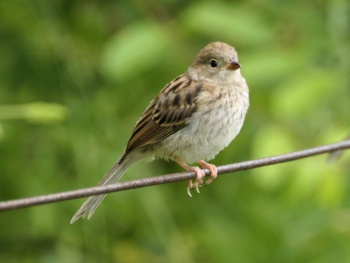- Spizella pusilla
Identification
Upperparts are brown with pale feather fringes and white wing bars. Breast and flanks are pale brown and belly is white. Tail is forked. The head shows rusty crown and eyeline separated by a grey supercilium. There is a white eye ring and the bill is pink.
Similar species
Summer plumage Chipping Sparrow differs in black eyeline, white supercilium and grey flanks.
Distribution
These birds are permanent residents in the southern parts of their range. Northern birds migrate to the southern United States and Mexico.
Taxonomy
Subspecies
This is a polytypic species, consisting of two subspecies[1]:
- S. p. pusilla: (A. Wilson, 1810)
- S. p. arenacea: (Chadbourne, 1886)
- Great Plains of central US; > to Gulf Coast and north-eastern Mexico
Habitat
Their breeding habitat is shrubby fields across eastern North America.
Behaviour
Diet
These birds forage on the ground or in low vegetation, mainly eating insects and seeds. They may feed in small flocks outside of the nesting season.
Breeding
The nest is an open cup on the ground under a clump of grass or in a small thicket.
Vocalisation
Song: an accelerating series of soft, sweet whistles that start with long duration tones and increase in rate to a trill.
References
- Clements, J. F., T. S. Schulenberg, M. J. Iliff, B.L. Sullivan, C. L. Wood, and D. Roberson. 2013. The eBird/Clements checklist of birds of the world: Version 6.8., with updates to August 2013. Downloaded from http://www.birds.cornell.edu/clementschecklist/download/
- BF Member observations
- Wikipedia
Recommended Citation
- BirdForum Opus contributors. (2024) Field Sparrow. In: BirdForum, the forum for wild birds and birding. Retrieved 26 December 2024 from https://www.birdforum.net/opus/Field_Sparrow
External Links
GSearch checked for 2020 platform.1






